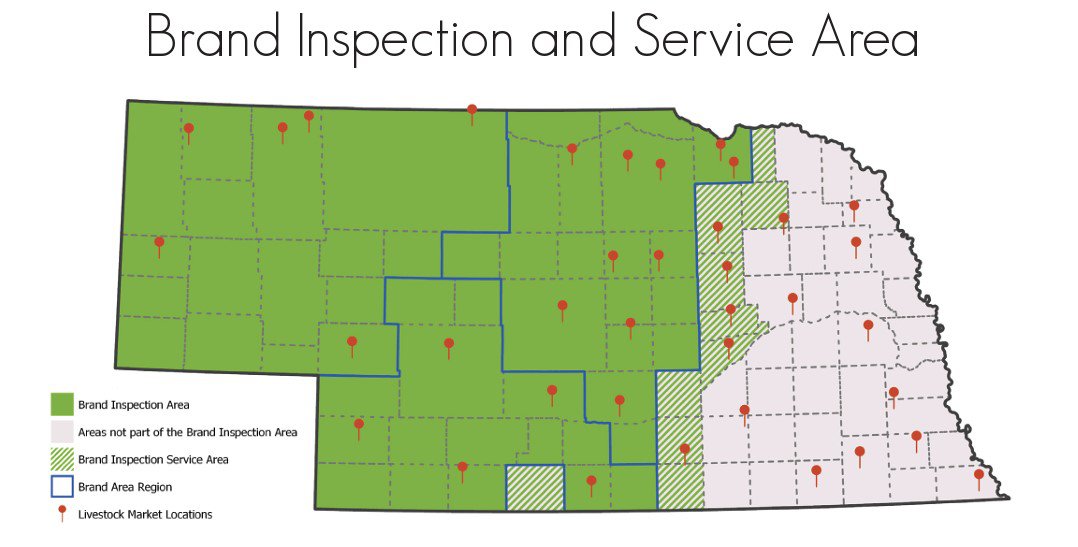By Brian Beach
It’s a windy March afternoon in Nebraska’s Medicine Valley.
On a ranch an hour south of North Platte, flat prairie quickly gives way to steep ravines. Cedar trees dot the landscape. And of course, there’s plenty of cattle grazing the countryside.
Marie Farr runs this cow-calf operation along with her husband and son. It’s ranches like this where cows are bred and give birth to calves.
The calves will eventually be branded with a hot iron in a distinct pattern, signifying their ownership to limit thefts and avoid mix-ups with neighboring herds. At Farr’s ranch, most cows and heifers have an XA brand on their left hide.
“You don't ever want to have your neighbors’ calves in with yours,” Farr said. “It happens, you know, you can tell by terrain, bulls fight, and cattle get mixed up, and if they lose their ear tag, you have to look to make sure they're branded.”
Once mature, the cattle will be sold to feedlots. But before they change ownership, typically at a sale barn, Farr must pay a brand inspector. She is charged one dollar per head of cattle inspected.
That’s because Farr’s ranch in Lincoln County is in the brand inspection area, which encompasses the western two-thirds of the state. If cattle leave the brand inspection area, Farr has to call her county’s brand inspector to her ranch.
“Before they're loaded on the trucks, they have to be inspected. And then he gives me my paper. I give him a check. And then we give the semis a little fleet permit. That way the truck drivers have a piece of paper that says, ‘This is what it is,' in case they get stopped," she said.
Farr is a volunteer committee member on the Nebraska Brand Committee, the agency responsible for conducting brand inspections. It also serves as the law enforcement agency for beef producers statewide.
“I'm passionate about the livestock industry and I'm passionate about the brand,” she said. “It's something I believe in. Brand is a proof of ownership of our livestock, of our livelihood. And so, yeah, I want to protect what’s mine from other people.”

Roughly 80 miles to the west, more than 60,000 cattle wander about at the Imperial Beef feed yard. Owner Brad Foote said cattle come here from across the country, from Virginia to California.
“It's hard to fill a 62,000 head feed yard,” he said. “You can't get them all from the Sandhills. It's just not economical, and there's too many seasonalities to it.”
They will stay at the feed yard for five to seven months, fattening up on a nutrient-dense mixture of corn, alfalfa, sileage and liquid supplements. Once they reach market weight, they will be shipped to a meatpacker.
Like Farr, Foote also has to pay a brand inspection fee, since he’s in the brand inspection area. But because he runs a registered feedlot, or RFL, he is charged an annual fee equal to the feedlot’s one time capacity – in his case, around $62,000.
In turn, brand inspectors check the feedlot’s files each quarter to ensure they’re in compliance with the brand law. Foote said the time required to put the paperwork together for the brand inspector is another hassle that goes beyond the monetary fee.
“It just adds complications to what we're doing,” he said. “We have all the information. We know they’re our cattle.”
In eastern Nebraska, feedlots don’t have required brand inspections. Neither do the operations in Kansas, where Foote Cattle Company owns other feedlots, nor in Texas, the number one cattle producing state in the country. Brand inspections are required in Wyoming, Colorado and counties west of the Missouri River in South Dakota.
Foote said he’s shipped more than two million cattle without any issues at any of his facilities – brand inspected or not. He doesn’t see any value in the inspections at Imperial Beef.
“If Elon Musk and DOGE looked at this, they this would be one of the first programs they'd eliminate, because this just doesn't make any sense,” he said. “This is wasteful government spending.”
But Foote said if ranchers want to keep brand inspecting at the cow-calf level, he's all for it.
“I don't even think it's necessary at the ranch level, but I don't want to change that. That's up to the rancher,” he said. “As a feed yard owner, I don't want to mess with anything that's going on at the ranch level, because I don't think that's my place.”
Click here to see more...